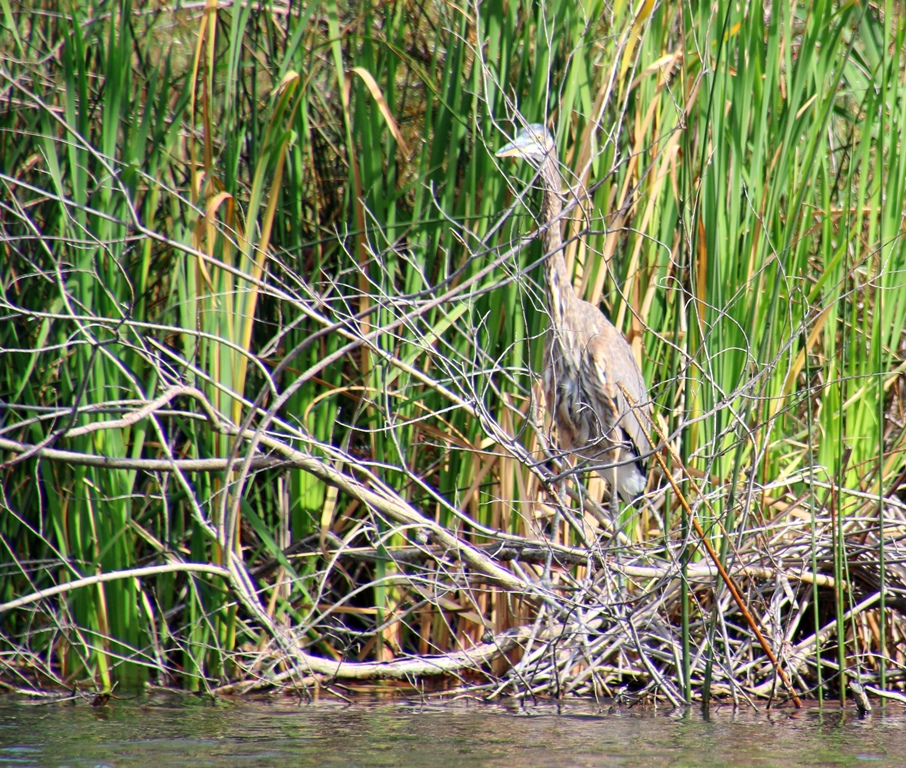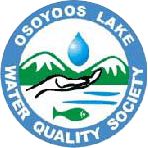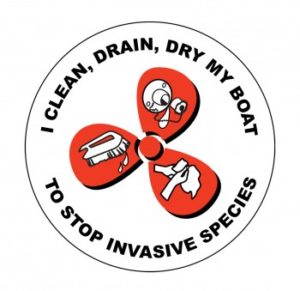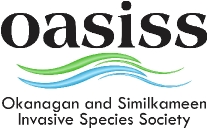Wildlife of Osoyoos Lake and Area

Can you spot the large bird disguised as shore brush in the oxbows at the north end of Osoyoos Lake? Photo Credit: Neil Bousquet
A unique ecosystem
Osoyoos Lake is beautiful. It teems with wildlife and many rare species that can only be found in its wetlands and oxbows.
Osoyoos and the southern part of the valley northward to Kaleden enjoys the arid desert habitat and climate shared by vast tracts of land to the south comprising the North American Desert. This is a conglomeration of hot deserts in Northern Mexico and California and the cooler, or cold, Great Basin Desert of Idaho, Utah and Nevada.
Our southern valley may be considered the final northern extremity of this system. The level benches, or Kame terraces that rise from the lakes and river course of the Okanagan are sedimentary deposits formed at the end of the last great ice age, and support a rich and diverse community of plants and animals known as the antelope-brush ecosystem. This is the pocket desert, an endangered and important Canadian ecosystem that defines Osoyoos and its surrounding area.
The entire valley serves as a crucial ‘corridor’ for migrating birds, animals and insects travelling between northern Canada and southern and central USA. Even plant life has used this corridor over time to spread grasslands from the south to the central interior of BC. Some of the migrant species and many of the resident species are on the endangered species list.
Osoyoos boasts its own climate zone, called the ‘Osoyoos Arid Biotic Zone’ hence the desert landscape and high summer temperatures.
All species in nature are part of a closely-linked chain, dependent on each other for food, shelter, and reproduction. This is particularly true in the Osoyoos area because there are several unique ecosystems that are linked to each other: the water courses and wetlands and the lush vegetation that surrounds them; the sagebrush, bunch grasses and antelope-brush habitat of the dry benchlands; the ponderosa pine/blue bunch wheat grass and rocky slope ecosystems; then at higher altitude, the Douglas fir and alpine meadows.
Osoyoos Lake and its adjacent riparian areas form an integral part of this chain: indeed, every lake, river and tributary of the Okanagan is of the utmost importance to the wildlife of this valley.
Rapidly disappearing
The area’s natural habitat is shrinking at an alarming rate due mostly to increased population and development. Other factors include agriculture and ranching, logging, golf course construction, and civil engineering and utility infrastructure.
The South Okanagan-Similkameen grasslands are among the top four most endangered ecosystems in Canada.
Wetlands in the Okanagan have been reduced to 5% compared to 100 years ago.
The Okanagan River was listed by Earthwild International in 2003 as the third most endangered river in Canada.
Osoyoos Lake and its surrounding area is home to one of the highest concentrations of endangered species in Canada.
Suggested areas to observe wildlife:
sẁiẁs Provincial Park (Haynes Point) and wetlands boardwalk area Hike & Bike trail along Okanagan River channel near Roads 18 & 22 for riparian birdwatching.
The bridge at Road 18 is probably the best place to watch sockeye salmon returning upriver to spawn – peaks in late October.
Strawberry Creek trail
Golden Mile trail
Below are some of the more well known or endangered species to be seen in and around Osoyoos Lake. This list is not intended to be fully inclusive.
Remember that wildlife surrounding Osoyoos Lake often overlaps with the wildlife of the Osoyoos desert ecosystem. Please check out the Osoyoos Desert Centre website for more information on plants, mammals and birds of the south Okanagan.
| Colour Key: | Endangered/Threatened Species: Red-Listed | Species considered threatened or vulnerable: Blue Listed | Commonly found species | Invasive species that are causing environmental problems due to increasing numbers |
| Amphibians | Habitat | Comments |
| Tiger Salamander | Wetlands, ponds, small lakes, grasslands | Small population, small BC range, declining |
| Great Basin Spadefoot Toad | Dry grasslands, wetlands, small ponds | Small BC population concentrated in S. Okanagan |
| Bullfrogs | Wetlands, lake shoreline, small ponds | Introduced to S. Okanagan about 30 years ago. Highly invasive |
| Reptiles | Habitat | Comments |
| Western Rattlesnake | Cliffs, grasslands, forest | Small BC population, slow reproductive rate, persecution |
| Yellow-bellied Racer | Grasslands, open forest, rock outcrops | Small BC population concentrated in S. Okanagan |
| Gopher Snake | Grasslands, shrub/steppe, open ponderosa pine forest | Small BC population concentrated in S. Okanagan |
| Painted Turtle | Wetlands, small ponds | Habitat threatened |
| Birds | Habitat | Comments |
| Loon | Lakes, wetlands | Shy and hard to find |
| Great Blue Heron | Wetlands, riparian woodland | Habitat threatened, sensitive to pollution |
| Sandhill Crane | Wetlands, Marshes | Small breeding population extirpated in S. Okanagan |
| Canada Goose | Parks, golf courses, areas of cut grass near water | Their excrement can carry serious disease |
| Mallard Duck | Ponds, lakes, rivers | Very common |
| Killdeer | Lake shorelines, wetlands | |
| Bald Eagle | Throughout the Okanagan/Similkameen | The juvenile is often mistake for the Golden Eagle |
| Osprey | Grasslands, riparian areas | Large nests are often built on telephone poles |
| Sage Thresher | Grassland, sagebrush shrub/steppe | Small population and range in BC, habitat threatened |
| Red-Tailed Hawk | Grassland, sagebrush shrub/steppe | |
| Red-Winged Blackbird | Wetlands, riparian areas | Migratory; they summer in the Okanagan |
| Plants | Habitat | Comments |
| Chocolate Lily | Mid and high mountain slopes, forest floors | |
| Antelope Brush | Shrub/steppe, grasslands | The S. Okanagan antelope brush ecosystem is one of the four most endangered ecosystems in Canada |
| Toothcup (Scarlet Ammannia) | Along lake shoreline | Habitat threatened |
| Oregon Grape | ||
| Russian Olive tree | Riparian areas, wetlands | |
| Bunchgrasses | Grasslands, sagebrush/steppe | |
| Eurasian Milfoil | Okanagan River and Osoyoos Lake | Highly invasive water weed |
| Purple Loosestrife | Stream and river banks, wetlands | A growing threat to the Okangan |
| Cattails | Stream and river banks, lake shoreline, wetlands | Commonly found |
| Sagebrush | Grassland adjacent to rivers and lakes in the S. Okanagan | There are three different varieties |
| Sumac | Grasslands, riparian areas | |
| Mammals | Habitat | Comments |
| Badger | Grasslands, open forests | Habitat loss, persecution |
| Nuttalls Cottontail Rabbit | Dry grasslands, open ponderosa pine forests | Small range in BC |
| Beaver | Ponds, rivers and streams | |
| Coyote | All elevations of the valley | |
| White-Tailed Deer | ||
| Mule Deer | ||
| Black Bear | Ponderosa pine forests | |
| Fish | Habitat | Comments |
| Sockeye salmon | Deeper waters of Osoyoos Lake | Habitat threatened by high temperatures, lack of oxygen and shade |
| Rainbow Trout | Wide-ranging throughout the lake | Introduced species |
| Widemouth Bass | Wide-ranging throughout the lake | Introduced species |
| Smallmouth Bass | Wide-ranging throughout the lake | Introduced species |
| Whitefish | Wide-ranging throughout the lake | Introduced species |
| Carp | Wide-ranging throughout the lake | Introduced species |
| Click here for more on fish and fishing in Osoyoos Lake | ||
| Crustaceans | Habitat | Comments |
| Western Ridge Mussel | Shallow waters and reeds along lake shoreline | Last seen in Osoyoos approx. 10 years ago |
| Mysis Shrimp | Osoyoos and Okanagan Lakes | Introduced in the 1960’s to provide food for declining salmon stocks: however it was found to compete with salmon fry for food |
| Insects | Habitat | Comments |
| Behr’s Hairstreak Buttterfly | Antelope/sagebrush grasslands | Habitat threatened |
More Info:
Endangered species and ecosystems (BC Ministry of Environment)
How the endangered species list works and how species are ranked (Provincial government)






